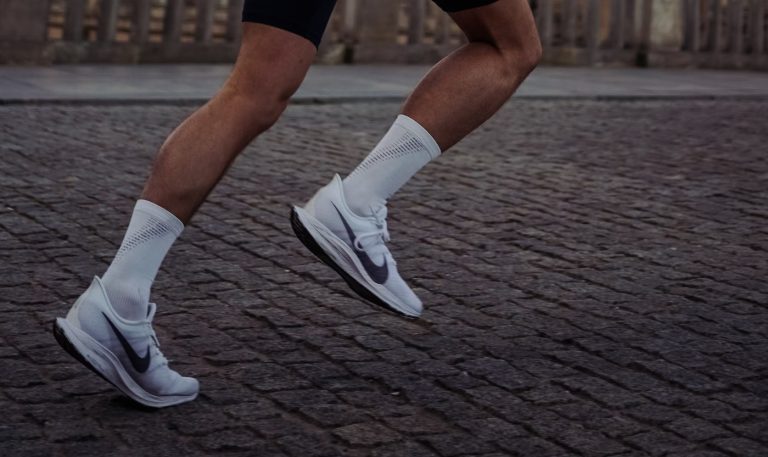Prevent and Treat Shin Splints: Our Expert Guide
Did you know shin splints, or medial tibial stress syndrome, make up 20% of running injuries? It’s a common problem that affects the shins, the area in front of your lower leg.
We want to help you prevent and deal with shin splints. You’ll learn about the signs, what causes them, and how to avoid them. Plus, we’ll talk about how to treat them and exercises to get better. It’s also important to see a doctor if you’re dealing with these.
Key Takeaways
- Shin splints, or medial tibial stress syndrome, are a common overuse injury affecting the shins.
- Symptoms include aching, throbbing, or stabbing pain in the shins, particularly during or after physical activity.
- Proper warm-up and cool-down exercises, running form, and gradual increases in training load can help prevent shin splints.
- Initial treatment often involves rest, ice, compression, and elevation (RICE), along with over-the-counter pain medication.
- Consulting a sports medicine professional is crucial for accurate diagnosis and personalized treatment plans.
Understanding Shin Splints
Shin splints are pain and swelling in the front of your lower leg, around the shinbone. They happen from doing a lot of running, jumping, or sports. Many people get them because of these activities.
What are Shin Splints?
Shin splints cause pain and swelling in the front of your shinbone. They happen when your leg gets too much stress from things like running and jumping. This can make the muscles and tendons in your shins hurt.
Symptoms of Shin Splints
Shin splint signs include aching or stabbing pain in your shins, especially after you’re active. There is also tenderness and swelling in your lower leg. This can stop you from doing your favorite activities.
Causes of Shin Splints
Shin splints can be caused by activities like running or playing sports. Things like wrong running form, bad shoes, and sudden training increases contribute too. These factors make your shinbone and the tissues around it stressed.
Shin Splints and Running
Many runners get shin splints because running is hard on the legs. This can cause swelling and pain, especially if you’re new to it or just started running more. To avoid this, it’s important to run with the right form, wear good shoes, and not push yourself too quickly.
Running can really stress the shins, which might cause shin splints if you’re not careful. A big part of staying safe is to not overdo it. This means not running too much too soon, using the right form, and knowing when to rest.
So, to stay away from shin splints, remember to run correctly, buy the best shoes you can, and slowly up your workouts. Following these tips can help runners stay free of injuries. Then, they can keep enjoying their runs without worry.
Risk Factors for Developing Shin Splints
Shin splints, also known as medial tibial stress syndrome, have several risk factors. It is important to know them to prevent and manage this overuse injury.
Overuse Injuries
Shin splints often happen because of overuse. Doing too much too soon with our shins can lead to pain. Activities with lots of impact or a sudden jump in training are common culprits.
Runners can get shin splints. Their sport’s high-impact nature strains their shins.
Improper Footwear
The wrong shoes can make shin splints more likely. Shoes lacking good fit or support put extra strain on our shins. This increases our chance of injury.
It helps to buy good running shoes for your feet and activities. Good shoes can prevent shin splints.
Biomechanical Factors
Biomechanical issues also up the shin splint risk. Elements like bad running form or muscle imbalance hurt our shins. Even flat feet or high arches can cause problems.
Focusing on good running form and using proper support can lower this risk. This includes strength training and sometimes orthotics.
Preventing Shin Splints
To stop shin splints, it’s key to warm-up and cool down well. Also, keep your running form sharp and slowly build up your training. Doing so can help us avoid the pain of shin splints and stay fit.
Warm-up and Cool-down Exercises
Start with dynamic stretches and easy moves to get your body ready. This eases it into the workout, sparing your shins. After the run, cool down with static stretches and foam rolling to help your legs heal.
Proper Running Form
Run correctly with a midfoot or forefoot landing to protect your shins. Paying attention to how you run spreads out the impact, lowering stress on your shins. Ask a coach or therapist to check your form for safety.
Gradual Increase in Training Load
Don’t rush into harder workouts; increase them slowly. Big jumps in activity can hurt your legs. Let your body get used to more work over time. This builds up your legs to handle more.

Doing all these things can cut down on shin splints. Being steady and getting advice from pros are important steps for keeping injuries away.!
Treating Shin Splints
The first step in treating shin splints is to rest and do ice therapy. This is known as RICE. It’s important to stop activities that make your shins hurt. This helps your body heal and lower swelling. Putting ice on your shins for 15-20 minutes a few times a day also helps.
Rest and Ice Therapy
Resting the leg that hurts and cutting back on physical activities is key. Choose activities like swimming or cycling that don’t stress your shins. Icing your shins often helps reduce the pain and swelling.
Compression and Elevation
Using a wrap or sleeve to wrap your shin can reduce pain and support your shin. Also, elevating your leg above your heart can reduce swelling. This helps blood flow and drains extra fluid. Doing this helps the shin heal faster.
Over-the-Counter Medications
Taking over-the-counter anti-inflammatory drugs like ibuprofen can help. They lower swelling and pain, so you can do your exercises. This is important for getting better from shin splints.
Rehabilitation for Shin Splints
To get better from shin splints and stop them from happening again, a full rehab plan is key. It has to include stretching and strengthening exercises, along with different exercises like swimming or cycling.
Stretching and Strengthening Exercises
Doing exercises to stretch and make the leg muscles stronger can lessen pain and make your legs work better. For shin splints, focus on moves like calf raises, heel drops, and strengthening the tibialis anterior. This helps the leg become more flexible, improves muscle balance, and keeps your lower leg steady, cutting down on getting hurt again.
Cross-Training Activities
It’s also good to mix in other types of exercise to your recovery plan. Things like swimming or biking are great for your heart but not tough on the shins. This keeps you active while your shins get better, stopping you from getting out of shape or hurting them more.
By sticking to a plan with stretching, strengthening, and different activities, you can get over shin splints and avoid them in the future. It’s smart to talk to experts like physical therapists to get a plan that fits you just right.
Shin Splints and Other Leg Pain
Shin splints are a common overuse injury. It’s key to tell them apart from other leg issues. This ensures the right treatment is given.
Differentiating Shin Splints from Other Conditions
Stress fractures are like tiny cracks in bones. They cause leg pain often worse than shin splints. Recovery is also longer for these.
Compartment syndrome is when muscle pressure increases. It causes leg pain along with numbness. Severe cases show tingling and other worse symptoms.
Tendinitis inflames your tendons. It feels a lot like shin splints with pain and swelling. But it often affects a specific tendon.
Getting a clear diagnosis is important. A sports doctor or therapist can help. They do tests and make a treatment plan for your exact issue.
Sports Medicine and Injury Prevention
Meeting with a healthcare pro is very important if you think you have shin splints. A sports med doctor or a PT can do a full check, look at other things it might be, and make a plan just for you.
Consulting a Healthcare Professional
If you have shin splints, getting help from sports med pros is key. They do a deep dive to find the cause and then create a special plan just for you. With their help, you get a fast and correct diagnosis to start healing right.
Role of Physical Therapists
PTs are super important for getting rid of shin splints and stopping them from coming back. They know how to set up exercises that target your exact issues. They also teach you the right way to train and keep from getting hurt again.
By teaming up with sports med folks and PTs, you’re doing a lot to handle shin splints and stay safe from other injuries. They guide you back to health and cheer you on to keep moving, staying fit.

Managing Pain from Shin Splints
Handling shin splint pain means using a mix of pain relief strategies and lifestyle modifications. You can take over-the-counter meds like acetaminophen or ibuprofen to ease the ache. For extra help, try heat or cold packs, wearing supportive braces, and doing relaxing activities like massage or foam rolling.
Pain Relief Strategies
To ease shin splint pain, use different methods. Over-the-counter drugs like acetaminophen or ibuprofen lessen the swelling and pain. Putting something warm or cold on the area can target the pain. Using braces or sleeves makes the shins more stable and lessens the strain. Relaxation methods like massage or foam rolling can also help a lot.
Insoles can help relieve and prevent shin splints by providing shock absorption, arch support, overpronation control, and cushioning. They reduce stress on the shins during high-impact activities. Choose insoles that fit well and suit your foot type and activity. Custom orthotics may be necessary for severe cases.Check here for more details about insoles relief foot pain.
Lifestyle Modifications
Changing your daily habits can help with shin splint pain. This might mean cutting back on how much you move to give your shins a break. Make sure you get enough rest and deal with any body alignment issues. These changes support healing and stop the injury from getting worse.
Conclusion
Shin splints or medial tibial stress syndrome are overuse injuries. They can heavily affect someone’s ability to be active and feel well. Knowing the causes, risks, and how to prevent them is key. Also, getting the right treatment and doing well with rehab can help a lot.
Sports medicine doctors and physical therapists are very important. They help with accurate diagnosis and planning the best treatment. With their help, beating shin splints is possible. We can reach our fitness and sports goals, even if we love to run a lot or do other activities that stress the body.
Prevention is key. This involves good training methods and getting quick treatment when needed. By taking these steps, we lower the chance of getting shin splints. It helps us stay active. With support from sports medicine, we tackle these common injuries. We become stronger and better because of it.







